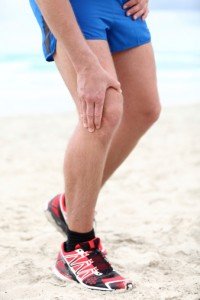What are the best treatments for Iliotibial Band Syndrome?
Iliotibial Band Syndrome, or IT band syndrome as it is more often referred to, is often misunderstood. What’s more, the average recreational runner has little idea of what treatments work best.
You are running along and you are feeling good, but gradually the outside of your knee begins to hurt. You struggle on, but before long the pain intensifies. It’s like someone is poking a knitting needle in your knee! The chances are you have Iliotibial band syndrome. But what is it exactly? And what should you do next?

Iliotibial Band Syndrome Treatment
What is the iliotibial band?
It’s a thick band of connective tissue that runs down the outside of the thigh. It runs from the hip to the shin, so needless to say it is very long.
It plays a crucial role in stabilising the knee, especially in runners. Unfortunately it has a relatively poor blood supply which hinders the healing process should injuries occur.
How does IT band syndrome occur?
If you do a lot of activity that involves knee flexion and extension (i.e. running), the iliotibial band might start to repeatedly rub over an area called the lateral femoral condyle. It’s a bony protuberance just above your knee joint. When this rubbing occurs it can become painful, and the pain continues to increase progressively if you continue the activity.
The most common cause is from overuse. The syndrome is particularly common in long distance runners. However, bad training practices can also contribute to the condition. In particular, if you spend all your time running on roads, you are likely to be more susceptible to the condition. Try to vary the types of terrain you run on.
If, on the other hand, you are a regular track runner, you might be exaggerating the condition by always running the same way around the track. Make sure to vary the direction you run on a regular basis. Other contributing factors can include; worn-down trainers, muscle tightness (especially in the hips) and muscle imbalance.
When it comes to stretching, the IT band is often an area that is overlooked. Most runners are familiar with calf, quad and hamstring stretches; but few remember to stretch the IT band. Familiarise yourself with IT band stretches, and make sure you make them a regular part of your routine.
How should you treat it?
Initial treatment for most overuse injuries remains the same: rest, ice, elevation and antiinflammatory medications. After that, I would highly recommend visiting a physiotherapist to assess your running technique and also to look at any underlying bio-mechanical issues. They may also want to assess whether you are wearing the proper shoes and decide if an orthotic shoe insert might help correct any imbalances.
As part of the rehabilitation process swimming, pool running, cycling, and rowing are all good alternatives to road running. As always massage is a great way to get suppleness back into the soft tissue – and if you are keen to keep pursuing your running, I would strongly suggest investing in a foam roller as well.
In the worst case scenarios a corticosteroid injection or even surgery may be needed. But my hope is that you will take every necessary precaution to avoid further injury so that does not become necessary.
We hope this information is useful for you. If you have any questions about our treatments, please contact us. You can find us in Mill Hill Broadway and Islington. If you like this blog, please share!
We are always happy to help.



